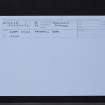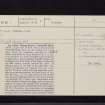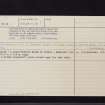Following the launch of trove.scot in February 2025 we are now planning the retiral of some of our webservices. Canmore will be switched off on 24th June 2025. Information about the closure can be found on the HES website: Retiral of HES web services | Historic Environment Scotland
Sleepy Knowe, Easterhill Head
Burial Cairn (Bronze Age), Cup Marked Stone(S) (Bronze Age), Inhumation (Bronze Age), Short Cist (Bronze Age), Cinerary Urn (Bronze Age)
Site Name Sleepy Knowe, Easterhill Head
Classification Burial Cairn (Bronze Age), Cup Marked Stone(S) (Bronze Age), Inhumation (Bronze Age), Short Cist (Bronze Age), Cinerary Urn (Bronze Age)
Canmore ID 53083
Site Number NT32SE 1
NGR NT 39286 20274
Datum OSGB36 - NGR
Permalink http://canmore.org.uk/site/53083
- Council Scottish Borders, The
- Parish Kirkhope
- Former Region Borders
- Former District Ettrick And Lauderdale
- Former County Selkirkshire
NT32SE 1 3929 2030.
(NT 3929 2030) Tumulus (NR)
OS 6" map (1900)
Clearly visible, 12 m. in diameter. Slopes 3 ft. high. Grass covered.
Information from A McVie 26 March 1953
This cairn - a grass-covered mound of stones - measures 12.0m. x 13.0m. x 0.5m. high. A modern shepherd's cairn stands upon its west side.
Visited by OS (JLD) 6 June 1962.
Field Visit (18 November 1953)
Cairn, 'Sleepy Knowe', Easterhill Head (NT 393 203).
About 130 yds ESE of BM 1168, on the summit of Easterhill Head, there are the remains of a round cairn which was completely excavated in 1869 (J Brydon 1869; 1871). Before excavation the cairn measured 36ft. in diameter and from 5ft. to 6ft. in height; it was composed of large stones, with a capping of smaller stones, and had been revetted by three or four layers of obliquely set slabs leaning inwards towards the centre. At different points in the body of the cairn there were found: (i) fragments of a Cinerary Urn, now in the Hawick Museum, which had been deposited, probably in an inverted position, in a built cavity or cist; (ii) a flat stone, 3ft. 3 in. long, decorated with incised lines and cup-markings; (iii) two other stones bearing cup-markings; (iv) a large, oval, undecorated stone which had been chipped into shape; and (v) numerous pockets of human and animal bones including portions of a human skull. On the floor of the cairn, about 6ft. W. of the centre, there was a short cist containing the remains of a male skeleton buried in the contracted position; while two deposits, each consisting of bones and small pieces of undecorated pottery, thinner and composed of finer clay than the cinerary Urn, were found also on the original surface, a short distance NE. of the centre of the cairn.
RCAHMS 1957, visited 18 November 1953
OS 6" map (1900) 'Tumulus'
Sbc Note
Visibility: This is an upstanding earthwork or monument.
Information from Scottish Borders Council












